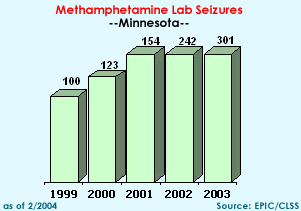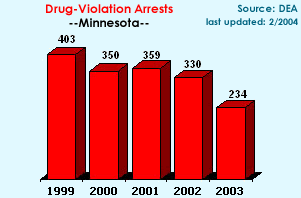|
 |
 DEA
Offices & Telephone Nos. DEA
Offices & Telephone Nos.
Minneapolis/St. Paul— 612-348-1700
|
State
Facts
Population: 4,972,294
Law Enforcement Officers: 9,521
State Prison Population: 12,200
Probation Population: 120,638
Violent Crime Rate
National Ranking: 40 |
2003
Federal Drug Seizures
Cocaine: 16.4 kgs.
Heroin: 0 kgs.
Methamphetamine: 15.2 kgs.
Marijuana: 1,056 kgs.
Ecstasy: 5 tablets
Methamphetamine Laboratories: 301 (DEA, state,
and local) |
Drug
Situation:In Minnesota, Mexican traffickers control the transportation,
distribution, and bulk sales of cocaine, marijuana, methamphetamine, and
small amounts of black-tar heroin. Numerous Mexican groups and street
gangs such as the Latin Kings are operating in the state. As a general
rule, the upper echelon Mexican distributors in Minnesota transport the
majority of their proceeds back to family members residing in Mexico.
At the retail level, independent African-American traffickers, African-American
street gangs, Native-American gangs, and independent white group purchase
cocaine, black-tar heroin, and marijuana from Mexican traffickers. In
outlying areas of the state, independent white groups and outlaw motorcycle
gangs distribute methamphetamine in small quantities. Street gang activity
in Minnesota has increased dramatically over the past few years. African-American
gangs appear to be primarily involved in the distribution of crack cocaine.
 Cocaine:
The majority of cocaine found in Minnesota is purchased from sources of
supply in California, Chicago, and Detroit. Some traffickers obtain cocaine
directly from sources of supply along the Southwest Border and transport
the cocaine to Minnesota themselves. Mexican traffickers control the transportation,
distribution, and bulk sales of cocaine. At the retail level, independent
African-American traffickers, African-American street gangs (specifically
the Gangster Disciples, the Vice Lords, and Crips), Hispanic street gangs
(specifically the Latin Kings), Native-American groups, and independent
white groups purchase cocaine from Mexican traffickers and distribute
it throughout Minnesota. In the Minneapolis-St. Paul metropolitan area,
crack cocaine is controlled by independent African-American traffickers
and African-American street gangs. Cocaine:
The majority of cocaine found in Minnesota is purchased from sources of
supply in California, Chicago, and Detroit. Some traffickers obtain cocaine
directly from sources of supply along the Southwest Border and transport
the cocaine to Minnesota themselves. Mexican traffickers control the transportation,
distribution, and bulk sales of cocaine. At the retail level, independent
African-American traffickers, African-American street gangs (specifically
the Gangster Disciples, the Vice Lords, and Crips), Hispanic street gangs
(specifically the Latin Kings), Native-American groups, and independent
white groups purchase cocaine from Mexican traffickers and distribute
it throughout Minnesota. In the Minneapolis-St. Paul metropolitan area,
crack cocaine is controlled by independent African-American traffickers
and African-American street gangs.
 Heroin:Heroin
distribution and use have not been significant problems in Minnesota,
but recent reports indicate there has been an increase in heroin use,
especially in the Minneapolis/St. Paul area. At the wholesale level, sources
of supply include Nigerian/West African traffickers operating from Chicago
and New York, African-American street gangs with ties to Chicago, and
Mexican traffickers operating from the Southwest Border and from Chicago.
At the retail level, heroin is distributed primarily by Hispanic and African-American
street gangs. Heroin:Heroin
distribution and use have not been significant problems in Minnesota,
but recent reports indicate there has been an increase in heroin use,
especially in the Minneapolis/St. Paul area. At the wholesale level, sources
of supply include Nigerian/West African traffickers operating from Chicago
and New York, African-American street gangs with ties to Chicago, and
Mexican traffickers operating from the Southwest Border and from Chicago.
At the retail level, heroin is distributed primarily by Hispanic and African-American
street gangs.
  Methamphetamine:
The meth threat in Minnesota is a two-pronged problem. First, large quantities
of meth produced by Mexican organizations based in California are
transported
into and distributed throughout the state. Second, meth increasingly
is being produced in small laboratories, capable of producing only
a few
ounces at a time. Mexican groups, who receive their product from the
West Coast, control distribution of the drug. These traffickers typically
send
meth from California through the U.S. mail, via Federal Express, and
by courier. Methamphetamine:
The meth threat in Minnesota is a two-pronged problem. First, large quantities
of meth produced by Mexican organizations based in California are
transported
into and distributed throughout the state. Second, meth increasingly
is being produced in small laboratories, capable of producing only
a few
ounces at a time. Mexican groups, who receive their product from the
West Coast, control distribution of the drug. These traffickers typically
send
meth from California through the U.S. mail, via Federal Express, and
by courier.
 Club
Drugs:Club drugs, including MDMA (Ecstasy), Ketamine, GHB,
GBL, Rohypnol, LSD, PCP, methamphetamine, nubain, and, to a lesser extent,
psilocybin mushrooms, have been reported in Minnesota. Club drugs are
most prevalent in Minneapolis' gay population, and to a lesser extent,
among young people at raves and nightclubs in suburban areas. Prior to
its placement in Schedule I in February 2000, Minnesota placed state controls
on the possession of GHB. Ketamine ("Special K") use first
appeared in Minnesota in 1997 among adolescents and young adults. Public
awareness
of the growing prevalence and dangers of club drug use has been heightened
by several recent incidents: five deaths involving MDMA, the meth-related
death of a teenager, several large law enforcement cases involving GBL,
and a police-related incident involving a youth on LSD. Club
Drugs:Club drugs, including MDMA (Ecstasy), Ketamine, GHB,
GBL, Rohypnol, LSD, PCP, methamphetamine, nubain, and, to a lesser extent,
psilocybin mushrooms, have been reported in Minnesota. Club drugs are
most prevalent in Minneapolis' gay population, and to a lesser extent,
among young people at raves and nightclubs in suburban areas. Prior to
its placement in Schedule I in February 2000, Minnesota placed state controls
on the possession of GHB. Ketamine ("Special K") use first
appeared in Minnesota in 1997 among adolescents and young adults. Public
awareness
of the growing prevalence and dangers of club drug use has been heightened
by several recent incidents: five deaths involving MDMA, the meth-related
death of a teenager, several large law enforcement cases involving GBL,
and a police-related incident involving a youth on LSD.
 Marijuana:
Marijuana remains the most commonly used and readily available drug
in Minnesota according to public health officials. The importation of
bulk marijuana shipments into the state of Minnesota is controlled
by
Mexican drug trafficking organizations. Hispanic street gangs are the
major distributors of marijuana at the retail level. Marijuana is
readily
available from local cultivators in addition to the supplies emanating
from the Southwest Border. In 2002, 5,427 cultivated plants were
seized
from 15 indoor grow operations, and 1,238 cultivated plants were eradicated
from 16 outdoor plots. Marijuana:
Marijuana remains the most commonly used and readily available drug
in Minnesota according to public health officials. The importation of
bulk marijuana shipments into the state of Minnesota is controlled
by
Mexican drug trafficking organizations. Hispanic street gangs are the
major distributors of marijuana at the retail level. Marijuana is
readily
available from local cultivators in addition to the supplies emanating
from the Southwest Border. In 2002, 5,427 cultivated plants were
seized
from 15 indoor grow operations, and 1,238 cultivated plants were eradicated
from 16 outdoor plots.
  Other
Drugs: The
use of diverted controlled substances in Minnesota continues to be a problem.
The most commonly diverted controlled substances from the licit market
are nubain, dilaudid, ritalin, vicodin (hydrocodone), oxycontin, codeine
combination products, the benzodiazepines, and the anorectic drugs phentermine
and phendimetrazie. Nubain is a prescription narcotic that has recently
emerged in the Minneapolis area. This narcotic is being used by body builders
who mistakenly believe it acts as a steroid. Four deaths have occurred
in the Minneapolis area as a result of nubain being taken with MDMA, and
OxyContin being mixed with cocaine. According to local addicts, Klonopin
is more readily available than in the past from illegal sources and prescriptions
are easily obtained from some doctors. In rural Minnesota it has also
appeared under its international, non-United States trade name, "Rivotril,"
which suggests its importation from foreign sources. Flunitrazepam, trade
name "Rohypnol," is a long-acting benzodiapine that is typically
combined with alcohol or other drugs to produce incapacitation and memory
loss similar to an alcohol-induced blackout. Minnesota law enforcement
agencies encountered only small amounts of the drug. Its use as a "date
rape" drug is not widespread in Minnesota. Other
Drugs: The
use of diverted controlled substances in Minnesota continues to be a problem.
The most commonly diverted controlled substances from the licit market
are nubain, dilaudid, ritalin, vicodin (hydrocodone), oxycontin, codeine
combination products, the benzodiazepines, and the anorectic drugs phentermine
and phendimetrazie. Nubain is a prescription narcotic that has recently
emerged in the Minneapolis area. This narcotic is being used by body builders
who mistakenly believe it acts as a steroid. Four deaths have occurred
in the Minneapolis area as a result of nubain being taken with MDMA, and
OxyContin being mixed with cocaine. According to local addicts, Klonopin
is more readily available than in the past from illegal sources and prescriptions
are easily obtained from some doctors. In rural Minnesota it has also
appeared under its international, non-United States trade name, "Rivotril,"
which suggests its importation from foreign sources. Flunitrazepam, trade
name "Rohypnol," is a long-acting benzodiapine that is typically
combined with alcohol or other drugs to produce incapacitation and memory
loss similar to an alcohol-induced blackout. Minnesota law enforcement
agencies encountered only small amounts of the drug. Its use as a "date
rape" drug is not widespread in Minnesota.
DEA
Mobile Enforcement Teams: This cooperative program with state
and local law enforcement counterparts was conceived in 1995 in response
to the overwhelming problem of drug-related violent crime in towns and
cities across the nation. There have been 409 deployments completed resulting
in 16,763 arrests of violent drug criminals as of February 2004. There
has been one MET deployment in the State of Minnesota since the inception
of the program: Minneapolis.
DEA
Regional Enforcement Teams: This program was designed to augment
existing DEA division resources by targeting drug organizations operating
in the United States where there is a lack of sufficient local drug law
enforcement. This Program was conceived in 1999 in response to the threat
posed by drug trafficking organizations that have established networks
of cells to conduct drug trafficking operations in smaller, non-traditional
trafficking locations in the United States. Nationwide, there have been
22 deployments completed resulting in 608 arrests of drug trafficking
criminals as of February 2004. There have been no RET deployments in
the State of Minnesota.
Special
Topics: The DEA Chicago Field Division is committed to fostering
cooperative efforts among federal, state, and local law enforcement agencies
within Minnesota. A task force consisting of two groups and funded by
DEA's State and Local Program is located in Minneapolis. There are 4 Task
Force Officers, representing 4 law enforcement agencies, assigned to DEA
in Minnesota. There are 23 funded Task Forces throughout Minnesota receiving
U.S. Department of Justice Byrne grant money. The DEA participates in
the Minneapolis Gang Strike Force (MGSF), which was created in 1997 to
combat escalating gang violence in the state. It operates six regional
offices. Currently there are over 5,000 confirmed gang members entered
into the Minnesota Gang Strike Force Intelligence System and 160 organized
gangs.
More information
about the Chicago Division Office.
Sources
Factsheet
last updated: 2/2004
Click
here for last year's 2003 factsheet>>
|

